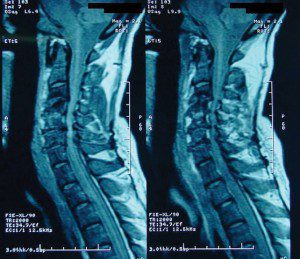

Other conditions, such as a herniated disc, can mimic stenosis. While herniated discs usually cause rapid and acute muscle spasm, discomfort caused by stenosis builds gradually. Other conditions that can be confused with stenosis include vascular claudication, peripheral vascular disease, and abdominal aortic aneurysms. Claudication—pain triggered by walking—caused by vascular disease most often occurs after walking a fixed distance. Patients with spinal stenosis, however, walk variable distances before symptoms set in. Activities like riding a bicycle and walking up a hill can cause pain in patients with vascular claudication, but not in those with stenosis. On the other hand, standing makes pain worse for stenotic patients, while it relieves vascular claudication.
The source of the stenosis often dictates the treatment. Although medications can provide pain relief, those powerful enough to eliminate the pain can also exacerbate patients’ already compromised sense of balance. When the patient loses bowel or bladder control, suffers from intolerable leg pain and claudication, and has progressive loss of function or spinal cord tumors, surgery is the first and only option. The standard stenosis surgical procedure usually involves opening up the spinal canal and decompressing the neural elements by removing the bony structures that contribute to canal narrowing. Although many patients do fairly well after the surgery, the symptoms are likely to return after a period of time. Recent studies show that although stenosis surgery will often have good results up to two years, in the long run, outcomes are much the same between surgery and conservative care. Some surgeries have to be repeated years later. Many are far from fully satisfactory. Surgery is a complicated procedure that irreversibly changes the structure of the back.
In many mild and moderate cases of stenosis, however, non-invasive conservative care, such as chiropractic, can help minimize pain and discomfort, maintain joint mobility, and allow the patient to keep a reasonable lifestyle, at least for some time. A technique called distraction manipulation may be helpful in reducing leg discomfort. Proper exercises are a major part of the conservative treatment program. It is recommended to exercise four or five times a week with physical activities such as riding on the bicycle or lying on the side and grasping the knees with the arms, focus on flexing the spine in a forward position—stretching and strengthening the lower back and stomach muscles and improving muscle strength. Exercises designed to mobilize the involved nerves have been found to be particularly helpful.
Ultimately, stenosis is a chronic condition that cannot be “cured,” but it often can be improved, and improvement can be maintained over the long term. Patients often work with a chiropractor to successfully relieve symptoms and improve their quality of life.
Dr. Pagano
5440 Park Central Ct. #2
Naples, Florida 34109
(239) 597-4355
 Southwest Florida's Health and Wellness Magazine Health and Wellness Articles
Southwest Florida's Health and Wellness Magazine Health and Wellness Articles
